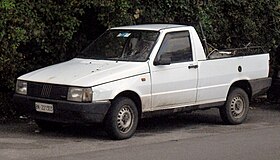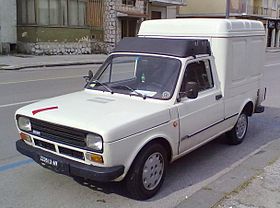
Fiat Fiorino Series 1 1977–1988

| Fiat Fiorino | |
|---|---|

Fiat Fiorino pickup, second generation
|
|
| Overview | |
| Manufacturer | Fiat |
| Production | 1977–present |
| Chronology | |
| Predecessor | Fiat 500 Commerciale |
The Fiat Fiorino is a small commercial vehicle produced by the Italian manufacturer Fiat since 1977.
Its first two generations have been the panel van derivatives of other small models, such as the Fiat 127 and Fiat Uno, while the current third generation was developed jointly with PSA Peugeot Citroën, and is based on the Fiat Small platformThe current generation, the Sevel LAV, is also built with a passenger body style, as the Fiat Qubo, and is marketed along its rebadged versions, the Citroën Nemo and the Peugeot Bipper. It is positioned below the Fiat Doblò, the Citroën Berlingo and the Peugeot Partner, in each manufacturer's model line-up.
The name comes from an old Italian coin, normally translated into English as the Florin.
First generation (1977–1988)
| First generation | |
|---|---|
 |
|
| Overview | |
| Also called | Fiat 127 Fiorino Fiat 147 Pick-Up City (Brazil) Emelba 127 Poker |
| Production | 1977–1988 1989–1995 (Argentina) |
| Assembly | Mirafiori, Turin, Italy Betim, Brazil (Fiat Automóveis) Córdoba, Argentina (Sevel) Catalonia, Spain (Emelba) |
| Body and chassis | |
| Class | Leisure activity vehicle/panel van pick-up |
| Layout | Front-engine, front-wheel-drive |
| Related | Fiat 127 Fiat 147 SEAT 127 |
| Powertrain | |
| Engine | 903 L 100 GL.000 OHV I4 petrol 1.049 L 127 A.000 OHC I4 petrol 1.301 L 127 D.000 SOHC I4 diesel |
| Dimensions | |
| Length | 3,835 mm (151.0 in) |
| Width | 1,564 mm (61.6 in) |
| Height | 1,810 mm (71.3 in) |
| Curb weight | 870 kg (1,918 lb) |

Originally called Fiat 127 Fiorino, the first version was based on the design of Series 2 Fiat 127 with the back being a van box, i.e. a 1.3 metres (4 ft 3 in) tall "high cube" design, an arrangement subsequently emulated by several European auto makers. The platform is a stretched version of the Brazilian 147 with different rear suspension.
It was launched in early November 1977, in panel van and passenger (Panorama) version with the same 903 L (100 GL.000) OHV I4 petrol engine and the 1.050 L (127 A.000) OHC I4, both used in the Fiat 127.
In 1981, Fiat introduced a facelift with new front fascia, similar to the similar to the Fiat 147 and the 127 Panorama; the 903 L engine was dropped and the new 1.301 L SOHC I4 diesel engine was introduced together the pick up version based on the stretched platform of the Brazilian Fiat 147 city pick up.
At the same time, Fiat dropped the name 127 in Europe, and called the vehicle Fiorino. In 1980, the Fiorino was launched in Brazil in panel van version, passenger version and pick up. Another facelift was launched in 1983, with the new front grille based on the South American Fiat 127 Unificata.
In Europe, Fiat sold the kit "Ognitempo", to transform the Fiorino into a mini camper.
The Fiorino was assembled from 1977 to 1981 in Mirafiori factory, Italy, alongside the Fiat 127. In 1980, Fiat started production in Minas Gerais plant, Brazil were the Fiat 147 (and related 127 Panorama) was manufactured and in 1981 transferred the european production from Mirafiori to Minas Gerais.
After Brazilian production ceased in 1988, the assembly line of Fiorino transferred in Argentina and continued to be manufactured by Sevel Argentina, and sold for the local market. 25,035 units of the first generation were built in the Cordoba factory between 1989 to 1995.
Spanish version

In Spain, a commercial vehicle based on the SEAT 127 (a Spanish version of the italian 127 built under license Fiat by SEAT) was produced from 1980 by coachbuilder Emelba and called the Emelba 127 Poker. The 127 Poker have a similar "high cube" box design of the Fiorino, but different rear doors, rear lights and the platform have a different rear suspension.
The 127 Poker was design by Elba Design studio and was available as a panel van, passenger version and pick-up with the 903 L Fiat petrol engine, and was sold in Spain by the SEAT dealerships. Production ended in 1986, when was replaced by the SEAT Terra, which shares the same engine as the SEAT 127. The Spanish 127 Poker was built in the headquarters of coachbuilder Emelba, based in Province of Girona, Catalonia.
Engines
| Model | Engine | Displacement | Power | Torque | Note |
|---|---|---|---|---|---|
| 0.9 8V petrol | I4 | 903 cc | 45 PS (33 kW; 44 hp) | 64 N·m (47 lb·ft) | |
| 1.05 8V petrol | I4 | 1049 cc | 50 PS (37 kW; 49 hp) | 77 N·m (57 lb·ft) | |
| 1.3 8V diesel | I4 | 1301 cc | 45 PS (33 kW; 44 hp) | 103 N·m (76 lb·ft) |
